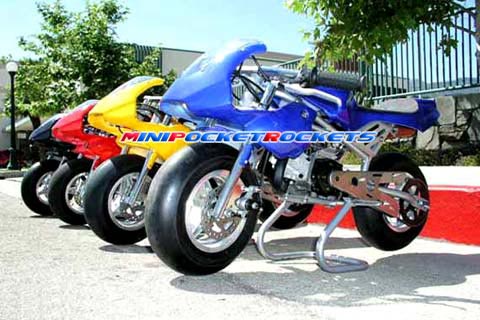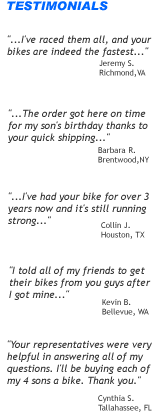POCKET MINI BIKE RACING
Please read the SAFETY section
of our site before you race or ride these pocket mini bikes
Racing these pocket mini bikes and scooters can be the most fun you can have on two
wheels. Because of their smaller size, less space is needed to sanction your own competitive events. Below are some suggestions
and pointers for those new to the sport that has been popular for many years in Europe and Japan.
Organized and Sanctioned events:
- check your local Go-Cart tracks. Many of these places
are now offering events for pocket mini bikes. This is
the safest way to compete, as there are trained staff
and crew members to supervise the events.
Suggestions for your own events:
- gather a few of your friends for some sunny and clear
daytime racing.
- find an abandoned parking lot or get permission from
businesses that have big parking lots; Schools, College
Campuses, Malls, Plazas and Event Stadiums are some suggestions.
- make sure the pavement is dry and smooth with minimal
concrete parking stops, speed bumps and islands. The best
racing grounds are those without any of the above obstacles.
- make sure there are no other moving vehicles, animals
or people that may obstruct your racing route.
- buy miniature pylons and cones to set up your track.
Ten cones should be sufficient to set up a decent sized
track.
- when riding, and especially when racing, make sure you
are wearing the proper safety equipment in case of a mishap.
Basics for riding fast:
- make sure your bike is well maintained and well lubed.
Proper tire pressure, chain tension, gas mixture and throttle
adjustment can make a big difference in speed between
two otherwise identical pocket mini bikes.
- cleaning your air filter and spark plug regularly can
also keep your pocket mini bike running at its optimal
speed.
- adjust the handlebars to the height and angle you feel
most comfortable when riding and cornering. This will
help in your speed and endurance during a long race.
Basics for cornering:
- the physics of these miniature bikes are the same as
their larger counterparts, only on a smaller scale.
- it is best to adjust your foot pegs so that it will
not come in counter with the ground as you lean your pocket
mini bike into a turn.
- never use your rear brake in a turn. Locking up the
rear brake in the middle of a turn can cause your bike
to slide and oversteer.
- when approaching a sharp turn, gradually lean your pocket
mini bike into the turn along with your body weight. Everything
should happen smoothly with no abrupt moves. As you hit
the apex of the turn, you can gently and progressively
tip in the throttle for the highest exit speed.
- a common practice in taking a very sharp turn is to
look for a virtual fulcrum (or pivot point), pretend to
anchor yourself to that point with a string, and tether
yourself through the turn using that point.
- with practice, many riders are able to lean these pocket
mini bikes through a turn, dragging the inside knee on
the ground. This is done to give the rider an idea of
where his or her bike is relative to the ground and provides
the fastest cornering speeds.
With a little research and planning, this
can be a very thrilling hobby. Organized events in your area
may have sanctioned races, where there are actually structured
qualifying and heat races with different classes for different
pocket mini bikes and riders (bikes classed by motor displacement,
modifications, etc).
Happy Racing,
The Team at MiniPocketRockets




